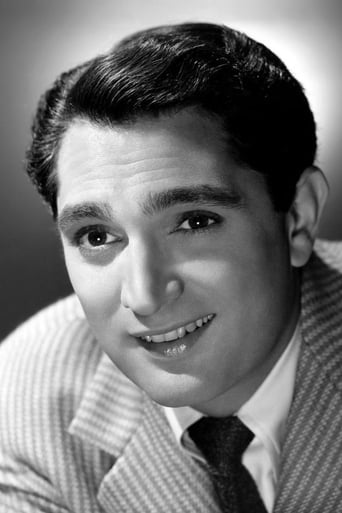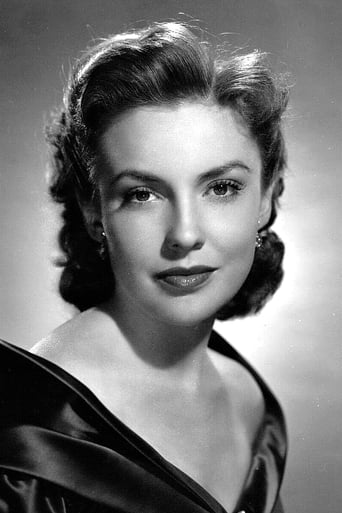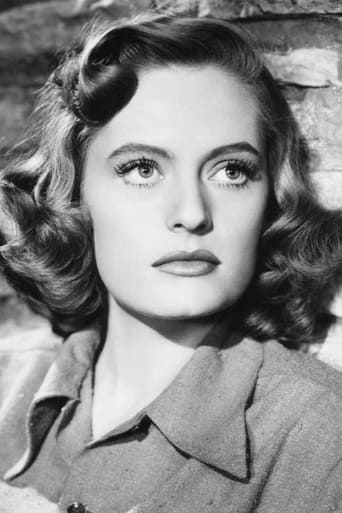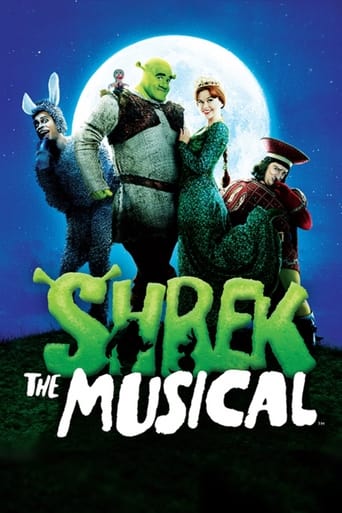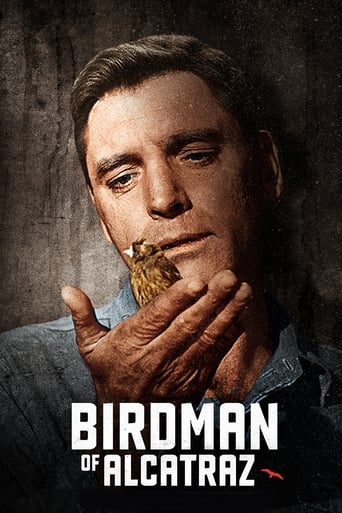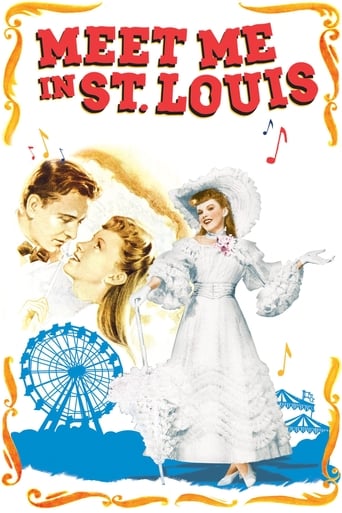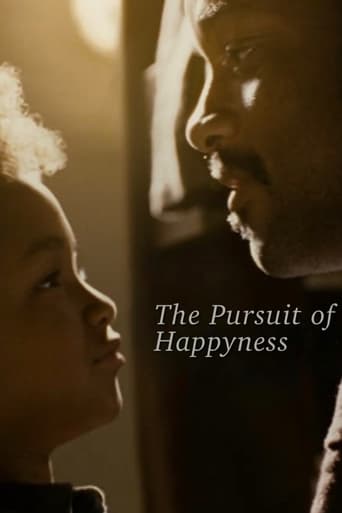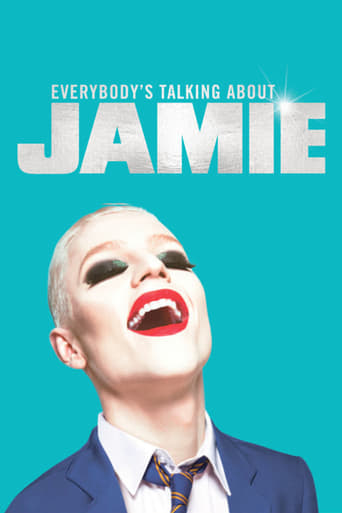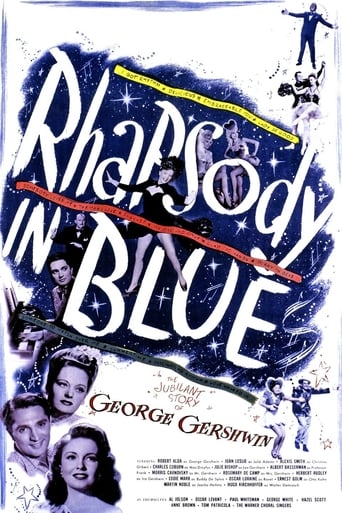
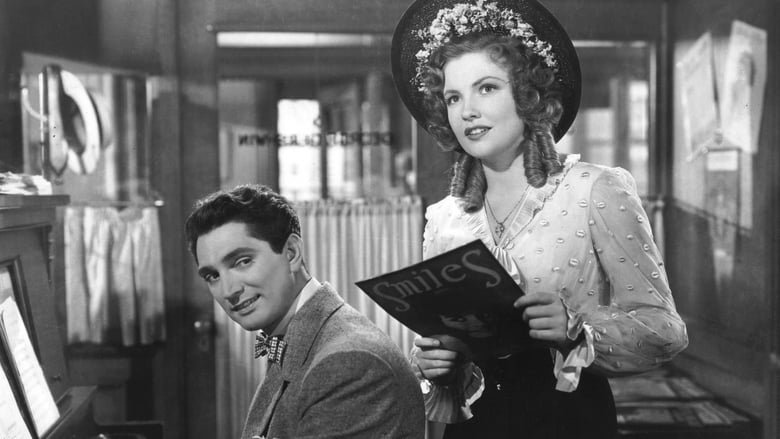
Rhapsody in Blue (1945)
Fictionalized biography of George Gershwin and his fight to bring serious music to Broadway.
Watch Trailer
Cast
Similar titles
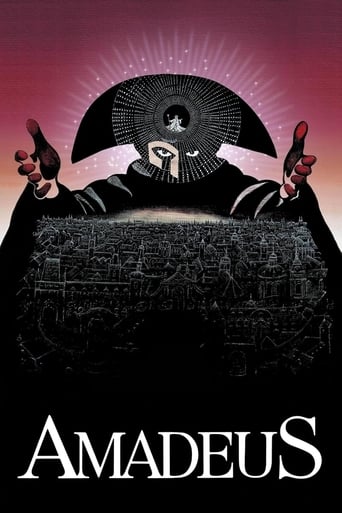
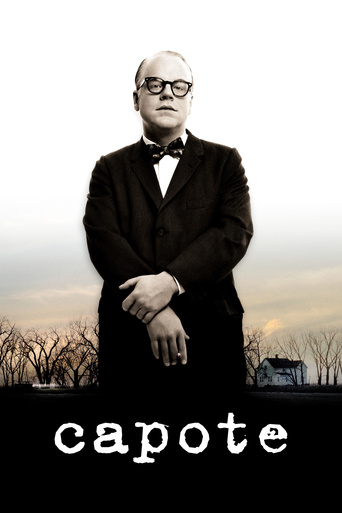

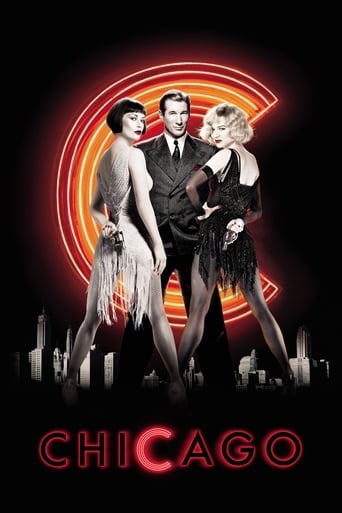
Reviews
It's no definitive masterpiece but it's damn close.
Best movie of this year hands down!
Admirable film.
Yo, there's no way for me to review this film without saying, take your *insert ethnicity + "ass" here* to see this film,like now. You have to see it in order to know what you're really messing with.
Copyright 22 September 1945 by Warner Bros, Pictures, Inc. A Warner Bros.-First National picture. Presented by Jack L. Warner. New York release at the Hollywood: 27 June 1945. U.S. release: 22 September 1945. U.K. release: 31 December 1945. Australian release: 30 January 1947. Sydney release at the Mayfair: 10 January 1947. 12,669 feet. 140½ minutes.SYNOPSIS: New York, 1918. Music publisher T.B. Harms (masque¬rading as "Max Dreyfus" in the film) introduces struggling young composer George Gershwin to Al Jolson, who sells over two million records and a million copies of sheet music of "Swanee". On the strength of this success, Harms induces George White to hire Gershwin to compose music for the Scandals. But despite writing song hit after song hit for White, Gershwin wants to compose "serious" music . . .NOTES: Rhapsody In Blue was panned by the critics and did not win either of the two Academy Awards for which it was nominated, but the nominees themselves are most interesting. For Best Scoring of a Musical Picture, the nominees for Rhapsody In Blue were Ray Heindorf and MAX STEINER. (Mr. Steiner is not credited on the actual film, but there can be no doubt that he worked extensively on the scoring). For Best Sound, the nominee was Nathan Levinson, head of the Warner sound department. (Anchors Aweigh won for Scoring, The Bells of St. Mary's for sound recording).COMMENT: Rapper's odd complaint about too much music (Rhapsody In Blue is a musical after all and personally I would rather have too little story than too much music) was also echoed by other critics. In fact, the film was almost universally panned on its first release and still has a poor reputation today.One of the main targets of dissatisfaction was the script. It is of course almost entirely mythical (and that in itself was enough to enrage most contemporary critics) but its dialogue seems less clichéd today (perhaps because less familiar) and compared to the sluggish pace of most current films, Rhapsody In Blue moves at such a fast clip that the hackneyed story and the honest endeavors of the players don't really matter all that much. What does matter is that the film speeds by in the grand 40's manner with great period sets teeming with costumed extras, atmospherically lit by probing camerawork, and underscored by marvelous music, superlatively, dazzlingly staged. From the early musical highlights of the film (Al Jolson singing and jigging "Swanee"; Tom Patricola dancing and singing "Somebody Loves Me" with Joan Leslie) through Whiteman and his orchestra rendering the title number to "An American In Paris" with its clever first-person camera (an excitement slightly dimmed by the obviously dated stock footage) to the dazzling special effects pyrotechnics of the final airlift from Oscar Levant's rapidly-fingered grand piano to the skies, Rhapsody In Blue is as visually captivating as aurally inspired.True, there are elements of the film which some may find irritating (Herbert Rudley, for instance, is totally inadequate for Ira Gershwin; Polito so heavily bathes Alexis Smith's face in light that you almost need sunglasses to watch her sequences; Albert Basserman and Morris Carnovsky are so clichéd and trite they are close to embarrassing) but these are trifles compared to the movie's dazzling succession of musical and visual riches.It must have been a disappointment to Warner and Lasky and all concerned, that a picture on which they had lavished so much money and painstaking care, with a roster of such players and singers and behind-the-camera talent, could be so universally panned. Fortunately for them, the general public of 1945 took little notice of newspaper critics. Rhapsody In Blue became one of the top money-makers of the year.SUMMING UP: A stunning, no-expense-spared musical biography. The musical sequences are both superlatively photographed and breathtakingly directed with some eye-numbing crane and tracking shots. An outstanding feast for Gershwin fans, it is nevertheless a pity so much of the story is fictitious, when the producers have taken such pains to recapture the atmosphere of the twenties. Many celebrities play themselves, and for others there are meticulously accurate impersonations. Rapper's direction is the most inventive of his career. He brings the script across with dramatic force and punch. Production values are first-class, with superlative sound recording.
As a biopic, Rhapsody in Blue will disappoint, but musically it is an epic feast that nobody can fail to delight in.Sure, the script is cliché-ridden and sentimental, the film is a bit too long and drags in places and those expecting accuracy or honesty here will be very short-changed, as with most music biopics of this period Rhapsody in Blue is heavily fictionalised. Herbert Rudley also felt undercast as Gershwin's brother Ira.On the other hand, Rhapsody in Blue does look good, with the costumes and sets evoking the period accurately and beautifully and the black and white photography is lovely (though maybe the film may have fared even better in colour). It's well directed, the musical numbers are well and solidly staged and the cast mostly do not disappoint. Robert Alda is a charismatic and likable Gershwin, Alexis Smith is charming and Rosemary DeCamp is compassionate and moving. There are also fabulous supporting turns from a pianistically brilliant and very funny Oscar Levant and a fabulously soulful Al Jolson, his rendition of Swanee being the film's high point. What really makes Rhapsody in Blue worth watching is the absolutely phenomenal music, there's lots of it, which will delight die-hard Gershwin fans, and it is all very well performed (Levant and Jolson in particular standing out).To conclude, a musical feast but could have been better if more attention was put into the biographical elements. 7/10 Bethany Cox
There was a time period, 1970-1971 when I had the good fortune of watching "Rhapsody In Blue".This time period for this reviewer was an interesting,perhaps even an exciting time as discoveries were being made.Those discoveries included the likes of "Yankee Doodle Dandy","They Died With There Boots On","Robin Hood","Its A Wonderful Life","Meet John Doe","You Can't Take It With You","Gentlemen Jim","Mr.Smith Goes To Washington",with "Rhapsody In Blue"being among such discoveries.The interest that these films provided were in part responsible for instilling the notion of wanting to act,that is just how interesting,perhaps exciting that the motion picture became.It was a real pleasure to view these films.There was help that came from the likes of Vincent Manelli,George Cukor,Frank Capra,William Wellman,Raoul Walsh and others.This help was a documentary that I recall watching on Channel 13 in the greater New York City area then as well.Not all Motion Pictures are worth there salt but these mentions are among those that have stood a test of time,most certainly the "Rhapsody In Blue" is one such mention.Discovering George Gershwin is the kind of pleasure that I would be happy if someone would say he had just discovered some great music.I perhaps would not say much at first but if encouraged by the others discovery I would recommend ... and so on.It need not of been any particular way but discovering Gershwin had to be appreciated with those that knew that music. It was that way for me when first I heard the "Rhapsody in Blue".I do not generally enjoy the unfortunate events that took George Gershwin so early but all that we have here is the realization that he was really a dynamo with a promise perhaps like Professor Frank argued maybe Gershwin was another Franz Shubert,perhaps even a Beethoven,maybe Prof.Frank was right about a-lot of things.This is the kind of pleasure that adds up to great.I truly enjoyed the scene when Max Dreyfus makes his case and tries to get Prof.Frank to agree.It is really great showmanship,and excellent movie making.The film has stayed with me as much because of the music as because of the appearances and performances of Oscar Levant,Al Jolson,Paul Whiteman,Hazel Scott,George White in person.When First I looked at and noticed Joan Leslie,Joan Leslie was that Hot Potato from "Yankee Doodle Dandy".Alexis Smith was worth a close look in "Gentlemen Jim" with Errol Flynn.I could only watch this film on Television at that point in time but recently its purchase was made possible on DVD.I have watched "Rhapsody in Blue" twice in less than 24 hours and "loving every minute of it".The "Rhapsody in Blue" is a very good movie perhaps a great movie.It was to me a motion picture that I wished for,like the sentiment expressed by George Bailey on the Bridge when it begins to snow.George Bailey is saying "I want to Live again,please I want to live again".The Film referred to is a Frank Capra film called "Its a Wonderful Life"."The Rhapsody in Blue" is a very excellent film,it is like living again.Worth a recommendation.
When I found this on YouTube in a Spanish-dubbed version without English subtitles, I first looked to see if an English-recorded one was on the site. Since there wasn't one, I decided to view the Spanish one especially since I knew at least the songs would stay in the original language no matter what foreign version occurs of whatever American musical movie made. With that said, while I didn't completely understand what was being spoken by the characters, the way some of the feelings was visualized did clue me in what was happening. Anyway, I at least loved most of the musical sequences especially when Ms. Joan Leslie showed her legs in a couple of her numbers. And seeing Robert Alda as George Gershwin convincingly looking like he's actually playing the piano-even though it's possible it's actually Oscar Levant's hands being spliced on screen when Alda's full body shot is shown-was also a pleasure to watch. I also liked Hazel Scott's singing of some of Gershwin's tunes though I didn't like it when she was partly cut during some of her numbers for some dialogue between Alda and other leading lady Alexis Smith. I also liked the "Blue Monday" sequence especially when the players seemed like white performers authentically having shaded skin in comparison to the Al Jolson "Swanee" number where he once again had the now-offensive burnt cork look that would now be appalling to African-Americans watching this today. In summary, the language barrier didn't ruin my enjoyment of the drama-fictionalized though it was-that occurred when depicting George Gershwin's life and besides, the music in the original English language was more than enough to carry my enjoyment through.
